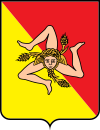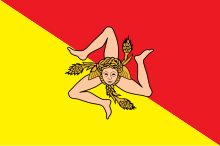Autonomous Region of Sicily
| Autonomous Region of Sicily | |
|---|---|
|
|
|
| Basic data | |
| Capital | Palermo |
| Provinces | 6 provinces and 3 metropolitan cities with 390 municipalities |
| surface | 25,702.82 km² |
| Residents | 4,968,410 (Dec. 31, 2019) |
| Population density | 193 inhabitants / km² |
| Website | www.regione.sicilia.it |
| ISO 3166-2 | IT-82 |
 Relief map of the Autonomous Region of Sicily |
|
The Autonomous Region of Sicily ( Italian Regione Siciliana ) is one of the 20 regions of the Italian Republic . It includes the island of Sicily and some offshore smaller islands and archipelagos.
The region has an area of 25,703 km² and 4,968,410 inhabitants (as of December 31, 2019), making its population density comparable to that of Italy itself. The capital and seat of government of the autonomous region as well as its most populous city is Palermo . Other big cities are Catania , Messina and Syracuse .
Political system
Sicily has the status of an autonomous region with a special statute (Italian Regione a statuto speciale ), which guarantees its own regional constitution and greater autonomy in the areas of administration and finance.
territory
The territory of the Autonomous Region of Sicily is defined in the Constitution (the special statute) of the region. In addition to the main island of Sicily, it includes the archipelagos of the Egadi , Lipari and Pelagie Islands as well as the individual islands of Ustica and Pantelleria .
Constitution
The Constitution of the Autonomous Region of Sicily is the special statute that has the status of an Italian constitutional law. The same conditions apply to changes to the special statute as to changes to the Italian constitution .
The special statute initially defines the territory of the Autonomous Region of Sicily. It then defines the constitutional bodies of the Autonomous Region of Sicily: the regional assembly as parliament and the regional cabinet and the president of the region as government.
The special statute regulates, among other things, the areas in which the Autonomous Region of Sicily has full legislative competence. These are above all the cultural goods, agriculture, fishing, territorial issues and tourism. The special statute also guarantees Sicily's financial sovereignty over its own tax revenues.
legislative branch

The Legislature of the Autonomous Region of Sicily is formed by the Sicilian Regional Assembly ( Assemblea Regionale Siciliana ) . The regional assembly consists of 70 members (up to 2017 there were 90), who are elected every five years.
Of the 70 seats will be
- 62 determined by proportional representation in the provinces or metropolitan cities. There is a 5% hurdle .
- 7 seats are on the list of the elected president of the region, including the president himself.
- 1 seat is reserved for the presidential candidate who was second in the election.
The seat of the Sicilian Regional Assembly is the Norman Palace in Palermo. The Sala d'Ercole (Hercules Hall) of this palace serves as a plenary hall for the assembly.
The last election to the regional assembly (17th legislative period) took place on November 5, 2017. Parliament President (Presidente dell'Assemblea) has since Gianfranco Micciché of Forza Italia .
executive
The executive of the Autonomous Region of Sicily is made up of the President of the Region (Presidente della Regione) and a cabinet (Giunta regional) made up of 12 ministers (Assessori Regionali) .
Since 2001, ministers do not have to be members of the regional assembly. Also since 2001 the president of the region (until then called Presidente della Giunta Regionale ) is no longer elected by the regional assembly, but directly by the population.
The seat of the presidents and the regional government is the Palazzo d'Orleans in Palermo on the Piazza Indipendenza to the west of the Norman Palace .
Since November 2017, the President of the Sicily Region has been Sebastiano Musumeci , founder and leader of the autonomist and right-wing party citizens' movement Diventerà Bellissima , whose name comes from a comment by the murdered Sicilian judge Paolo Borsellino . The incumbent Sicilian regional government consists of the following people:
| Regional Minister (Assessor) | Political party | Responsibilities |
|---|---|---|
| Sebastiano Musumeci | Diventerà Bellissima | President of the Region |
| Gaetano Armao | Forza Italia | Vice President, Economy and Finance |
| Edy Bandiera | Forza Italia | Agriculture, rural development, fishing |
| Toto Cordaro | Popolari e autonomisti | Spatial planning and the environment |
| Marco Falcone | Forza Italia | Infrastructure and traffic |
| Sebastiano Musumeci ( interim ) | Diventerà Bellissima | Energy and public services |
| Bernadette Grasso | Forza Italia | Local authorities and administration |
| Mariella Ippolito | Popolari e Autonomisti | Family, social policy and work |
| Roberto Lagalla | Idea Sicilia | Education and professional training |
| Sandro Pappalardo | Fratelli d'Italia | Tourism, sports and events |
| Ruggero Razza | Diventerà Bellissima | Healthcare |
| Sebastiano Tusa | independent | Cultural assets and Sicilian identity |
| Girolamo Turano | Unione di Centro | Commercial and industrial |
Parties
The major political parties in Italy are also represented in Sicily. There are also some smaller regional parties in Sicily.
Political structure
The Autonomous Region of Sicily is divided into six free municipal consortia and three metropolitan cities, which in turn are divided into a total of 390 municipalities . The free community consortia or metropolitan cities are named after their respective capitals. The administrative unit with the most inhabitants and the largest area is the metropolitan city of Palermo, the most densely populated is the metropolitan city of Catania and the metropolitan city of Messina has the most municipalities.
| Free community consortium or metropolitan city |
Capital | ISO | Communities | Population (December 31, 2019) |
Area (km²) | Population density (inh / km²) |
|---|---|---|---|---|---|---|
| Agrigento | Agrigento | IT-AG | 43 | 429.611 | 3,052.59 | 141 |
| Caltanissetta | Caltanissetta | IT-CL | 22nd | 260.779 | 2,138.37 | 122 |
| Catania | Catania | IT-CT | 58 | 1,104,974 | 3,552.20 | 311 |
| Enna | Enna | IT-EN | 20th | 162,368 | 2,574.70 | 63 |
| Messina | Messina | IT-ME | 108 | 620.721 | 3,247.34 | 191 |
| Palermo | Palermo | IT-PA | 82 | 1,243,328 | 4,992.23 | 249 |
| Ragusa | Ragusa | IT-RG | 12 | 321.215 | 1,614.02 | 199 |
| Syracuse | Syracuse | IT-SR | 21st | 397.037 | 2,124.13 | 187 |
| Trapani | Trapani | IT-TP | 24 | 428.377 | 2,460.08 | 174 |
| Sicily | Palermo | IT-82 | 390 | 4,968,410 | 25,702.82 | 193 |
economy
With a GDP per capita of 17,600 euros, which is only 61% of the EU average in purchasing power parity , Sicily is one of the poorest regions in Italy. With a value of 0.845, Sicily ranks last among the 20 regions of Italy in the Human Development Index .
The unemployment rate was 21.5% in 2017 and was one of the highest in Italy and all of Europe. Almost half of all young people had no job.
| year | 2006 | 2007 | 2008 | 2009 | 2010 | 2011 | 2012 | 2013 | 2014 | 2015 | 2016 | 2017 |
|---|---|---|---|---|---|---|---|---|---|---|---|---|
|
Unemployment rate (in%) |
13.4% | 12.9% | 13.7% | 13.8% | 14.6% | 14.3% | 18.4% | 21.0% | 22.2% | 21.4% | 22.1% | 21.5% |
history
The special statute of the autonomous region of Sicily was adopted before the constitution of the Italian Republic and was signed by King Umberto II on May 15, 1946 . This statute was intended to take the wind out of the sails of the separatist efforts in Sicily. In 1947 the first regional assembly of Sicily was elected. On February 26, 1948, the statute was converted into a constitutional law of the Italian Republic.
Until 2001 the president of the regional government (Presidente della Giunta Regionale) was elected by the regional assembly. In 2001 direct elections were introduced by the population and the official title was changed to "President of the Region" (Presidente della Regione) .
State symbols
The national symbols of the Autonomous Region of Sicily are the coat of arms and the flag of Sicily . Both show the colors of the region, yellow and red, in triangular form and in front of them the symbol of the triskele . The coat of arms and flag go back to the Sicilian Vespers in 1282. In their current form, they were declared official symbols of the Autonomous Region of Sicily in February 2000.
Web links
- Regione Siciliana , official website of the Autonomous Region of Sicily (Italian)
- Assemblea Regionale Siciliana , official website of the Sicilian Regional Assembly (Italian)
- Statuto della Regione Siciliana on the website of the Sicilian Regional Assembly (Italian; PDF; 36 kB)
Individual evidence
- ↑ Statistiche demografiche ISTAT. Monthly population statistics of the Istituto Nazionale di Statistica , as of December 31 of 2019.
- ↑ cf. Name on official website
- ↑ Elezioni Regionali 2017. In: Regione Sicilia. Retrieved October 18, 2018 (Italian).
- ^ Giornale di Sicilia, July 19, 2016
- ↑ Eurostat. Retrieved April 15, 2018 .
- ^ Sub-national HDI - Area Database - Global Data Lab. Retrieved August 12, 2018 .
- ↑ Regional Unemployment by NUTS 2 region .
Coordinates: 37 ° 34 ' N , 14 ° 16' E





